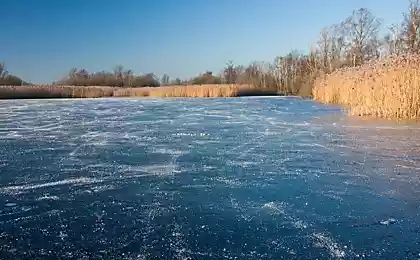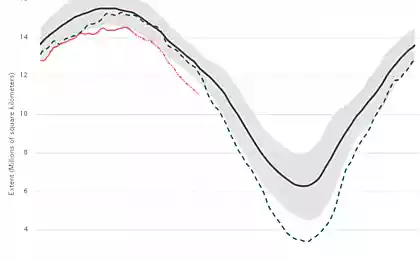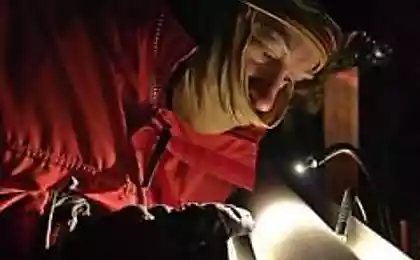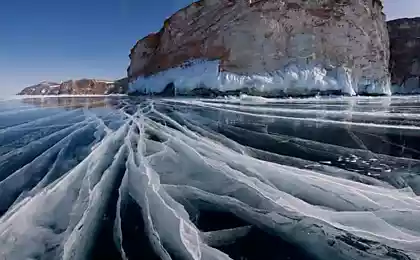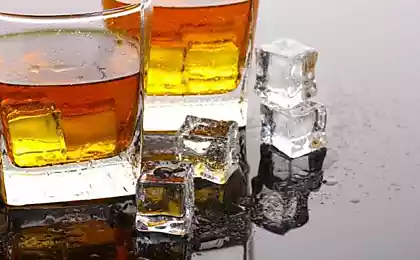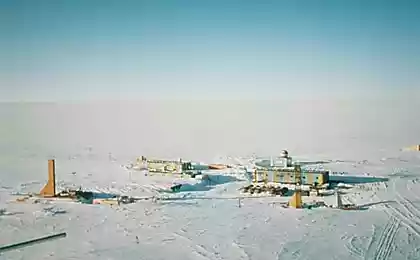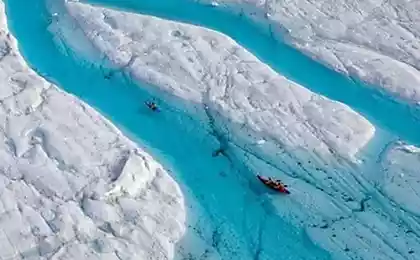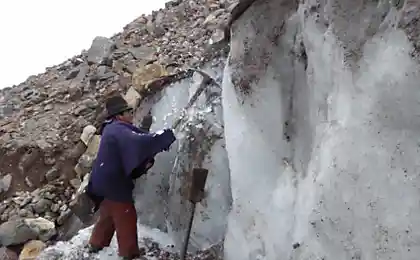1109
Under the ice (27 photos)
The signal is similar to clicking the cricket sounds of this music to the ears of the submarine crew members «New Hampshire», because he transferred from a container on the frozen surface of the Arctic Ocean camps. Using a digital communication system «Deep Siren» and underwater telephone, located in the Arctic lab Navy helped the submarine find a site relatively free of ice to float to the surface and bring the victim to the hospital sailor.


In the photo: members of the team submarine «New Hampshire», pops up to the surface in the area with a thin ice cover.
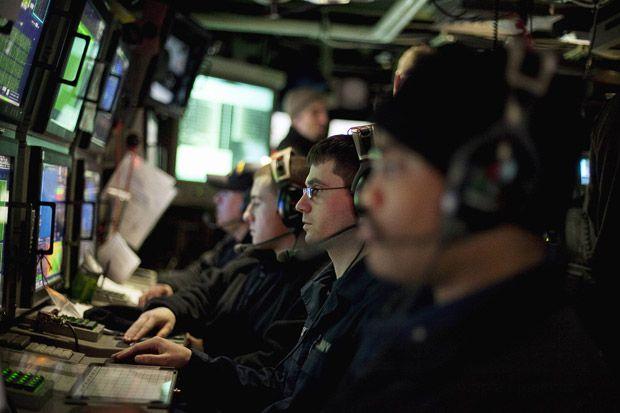
Photo: cabin submarine «New Hampshire».

The low-frequency system is designed by «Raytheon Co», and work on it has taken several years. The project cost amounted to 5, $ 2 million start-up capital was provided by the Office of the Navy. In the photo: submarine «Connecticut».

The company «Raytheon Co» - one of the last who dealt with the issue of communication between the submarines located at great depths. Past systems have proven to be ineffective, expensive and unnecessary complications. Photo: Keith Magness sawing ice on the hatches of the submarine «Connecticut».
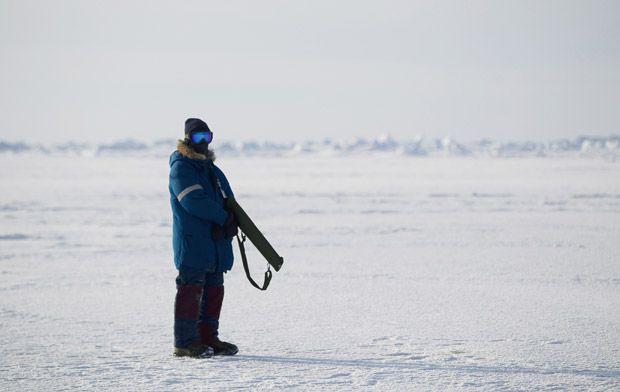
The new system will help to establish a worldwide communication between the submarine and the commanders on the ground. In the photo, one of the crew members of the submarine «Connecticut», armed with a shotgun - a meeting with a polar bear are not uncommon.
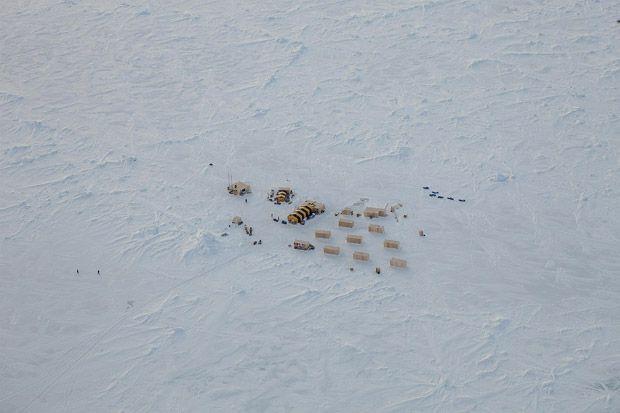
The system will send a warning about a submarine enemy ship on the surface, or pass an order for a new mission. In submarine would not be necessary to surface to a depth of 60 feet, as before. Accordingly, reduced risk of detection. Photo: Arctic Research Station "2011 Applied Physics Laboratory».
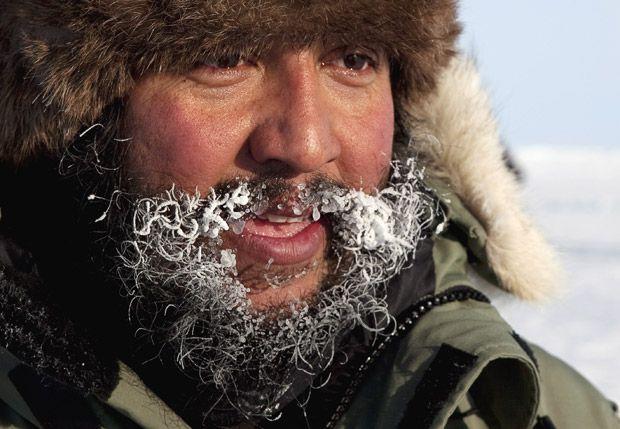
At present, submarines use an underwater telephone connection to communicate with the mainland and other submarines, but these devices are too primitive and only work at close range. In the photo: worker research station "2011 Applied Physics Laboratory» Hector Castillo waits to be freed from the ice hatches of the submarine «Connecticut».
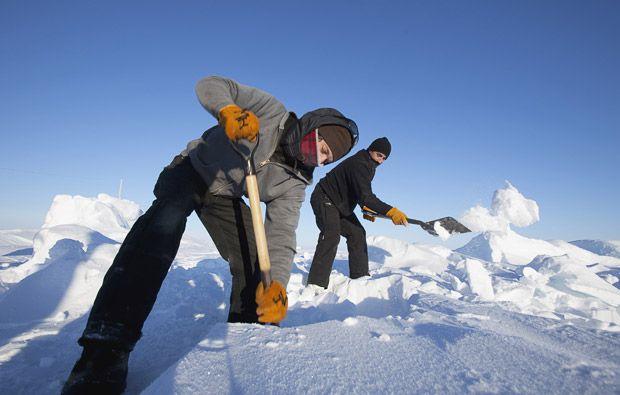
Submarines can use an antenna, only rising to a depth of less than 60 feet, but they are easier to detect. In the photo: worker research station «2011 Applied Physics Laboratory» Nick Michael Hart, left and Lieutenant Brandon Smith cut through the ice holes for locating equipment.

Communication between submarines located at any depth and any distance from each other - this is a huge step forward, said Matthew Pesce, a former submariner, who now works at the research station «2011 Applied Physics Laboratory».

Matthew Sand lives in Hawaii, but became a member of the team submarine «New Hampshire» as an expert on technical issues and equipment, including the communication system «Deep Siren». He argues that the system is very effective and messages are transmitted almost always full. In the photo: worker research station «2011 Applied Physics Laboratory» Nick Michael Hart with the drilling rig and the group of experts prepared a place for locating equipment.

The new communication system has already aroused the interest of other countries. It is planned to conduct two tests on submarines from other countries this year. In the photograph: for making holes in the Arctic ice is used pumped hot water.

Matthew Pesce said that the system allows the submarine to find a site relatively free of ice to float to the surface. In the photo: workers research station «2011 Applied Physics Laboratory» Nick Michael Hart and Kate Magness (left) hole was drilled in the Arctic ice for the radar installation tools.

Steven Moynahen, a senior engineer of the company «Raytheon Co», said that in its original version, the new communication system, developed by Scotsman Robert Kerr, was not designed for the transmission of large amounts of data, but that its simplicity makes it effective, especially in the financial crisis. "This is absolutely revolutionary new technology!" Says Moynahen. Photo: cable equipment, leaving a hole in the ice.

"Communication between the submarines largely remained the same as it was 60 years ago," says Jerry Pauley, vice president of the company «Network Centric Systems», a subsidiary of the company "Іntegrated Communications Systems». The combination of satellite communications with the new system «Deep Siren» allows ground commanders contacted submarine located at any point on the globe, at any depth. " In the photo: the pilot uses a GPS receiver to calculate the coordinates of the station "2011 Applied Physics Laboratory» in northern Alaska.

One of the employees of the station «2011 Applied Physics Laboratory» driven generator for refueling.

Using radio to check the origin of products after delivery to the remote station.

Helicopter resets reserves products which is in a remote area of the station, which is a structural subdivision of the station «2011 Applied Physics Laboratory».
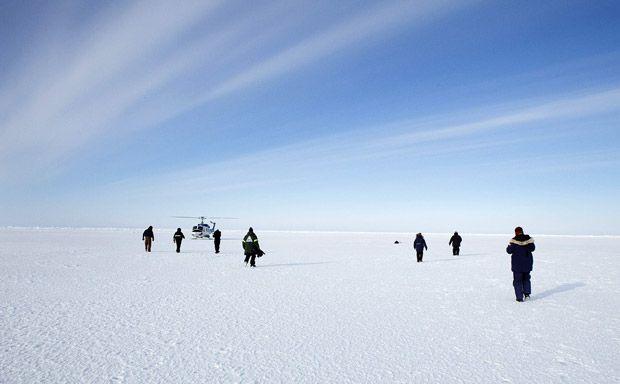
Workers returned to the helicopter after the delivery of products located in a remote area of the station.

Congressman Andrew Crenshaw studying the ice not far from the station "2011 Applied Physics Laboratory».

The helicopter flies to the station «2011 Applied Physics Laboratory».
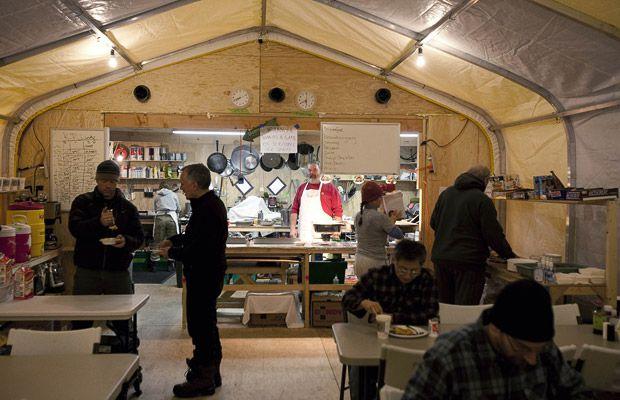
Dining at the station «2011 Applied Physics Laboratory».
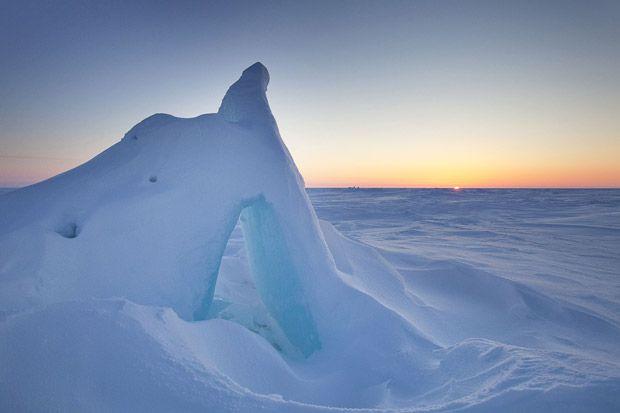
Sunset over the station «2011 Applied Physics Laboratory».

Helicopter approaches located in a remote area of the station, which is a structural subdivision of the station «2011 Applied Physics Laboratory».

Moonrise over the station «2011 Applied Physics Laboratory».
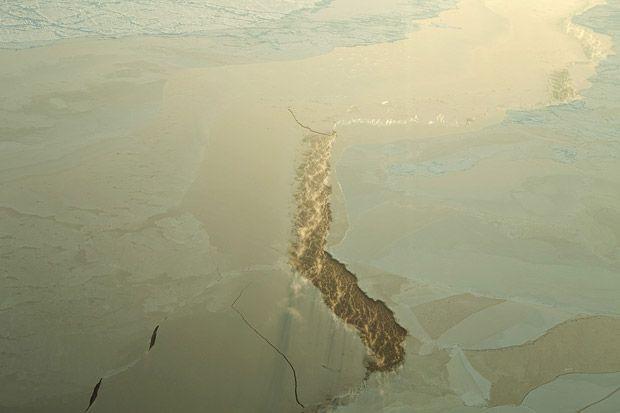
The steam from the sea water rises above the crack in the ice.
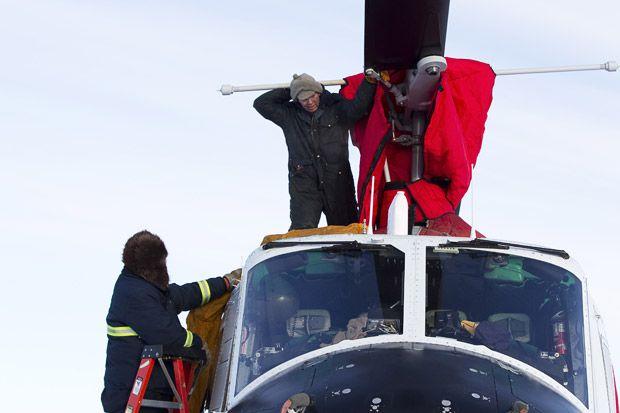
Workers wear protective capsule on the engine and main rotor of the helicopter.
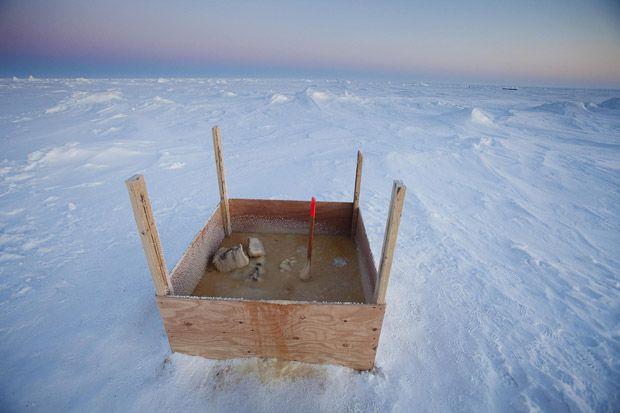
Storeroom at the station «2011 Applied Physics Laboratory».
via daypic


In the photo: members of the team submarine «New Hampshire», pops up to the surface in the area with a thin ice cover.

Photo: cabin submarine «New Hampshire».

The low-frequency system is designed by «Raytheon Co», and work on it has taken several years. The project cost amounted to 5, $ 2 million start-up capital was provided by the Office of the Navy. In the photo: submarine «Connecticut».

The company «Raytheon Co» - one of the last who dealt with the issue of communication between the submarines located at great depths. Past systems have proven to be ineffective, expensive and unnecessary complications. Photo: Keith Magness sawing ice on the hatches of the submarine «Connecticut».

The new system will help to establish a worldwide communication between the submarine and the commanders on the ground. In the photo, one of the crew members of the submarine «Connecticut», armed with a shotgun - a meeting with a polar bear are not uncommon.

The system will send a warning about a submarine enemy ship on the surface, or pass an order for a new mission. In submarine would not be necessary to surface to a depth of 60 feet, as before. Accordingly, reduced risk of detection. Photo: Arctic Research Station "2011 Applied Physics Laboratory».

At present, submarines use an underwater telephone connection to communicate with the mainland and other submarines, but these devices are too primitive and only work at close range. In the photo: worker research station "2011 Applied Physics Laboratory» Hector Castillo waits to be freed from the ice hatches of the submarine «Connecticut».

Submarines can use an antenna, only rising to a depth of less than 60 feet, but they are easier to detect. In the photo: worker research station «2011 Applied Physics Laboratory» Nick Michael Hart, left and Lieutenant Brandon Smith cut through the ice holes for locating equipment.

Communication between submarines located at any depth and any distance from each other - this is a huge step forward, said Matthew Pesce, a former submariner, who now works at the research station «2011 Applied Physics Laboratory».

Matthew Sand lives in Hawaii, but became a member of the team submarine «New Hampshire» as an expert on technical issues and equipment, including the communication system «Deep Siren». He argues that the system is very effective and messages are transmitted almost always full. In the photo: worker research station «2011 Applied Physics Laboratory» Nick Michael Hart with the drilling rig and the group of experts prepared a place for locating equipment.

The new communication system has already aroused the interest of other countries. It is planned to conduct two tests on submarines from other countries this year. In the photograph: for making holes in the Arctic ice is used pumped hot water.

Matthew Pesce said that the system allows the submarine to find a site relatively free of ice to float to the surface. In the photo: workers research station «2011 Applied Physics Laboratory» Nick Michael Hart and Kate Magness (left) hole was drilled in the Arctic ice for the radar installation tools.

Steven Moynahen, a senior engineer of the company «Raytheon Co», said that in its original version, the new communication system, developed by Scotsman Robert Kerr, was not designed for the transmission of large amounts of data, but that its simplicity makes it effective, especially in the financial crisis. "This is absolutely revolutionary new technology!" Says Moynahen. Photo: cable equipment, leaving a hole in the ice.

"Communication between the submarines largely remained the same as it was 60 years ago," says Jerry Pauley, vice president of the company «Network Centric Systems», a subsidiary of the company "Іntegrated Communications Systems». The combination of satellite communications with the new system «Deep Siren» allows ground commanders contacted submarine located at any point on the globe, at any depth. " In the photo: the pilot uses a GPS receiver to calculate the coordinates of the station "2011 Applied Physics Laboratory» in northern Alaska.

One of the employees of the station «2011 Applied Physics Laboratory» driven generator for refueling.

Using radio to check the origin of products after delivery to the remote station.

Helicopter resets reserves products which is in a remote area of the station, which is a structural subdivision of the station «2011 Applied Physics Laboratory».

Workers returned to the helicopter after the delivery of products located in a remote area of the station.

Congressman Andrew Crenshaw studying the ice not far from the station "2011 Applied Physics Laboratory».

The helicopter flies to the station «2011 Applied Physics Laboratory».

Dining at the station «2011 Applied Physics Laboratory».

Sunset over the station «2011 Applied Physics Laboratory».

Helicopter approaches located in a remote area of the station, which is a structural subdivision of the station «2011 Applied Physics Laboratory».

Moonrise over the station «2011 Applied Physics Laboratory».

The steam from the sea water rises above the crack in the ice.

Workers wear protective capsule on the engine and main rotor of the helicopter.

Storeroom at the station «2011 Applied Physics Laboratory».
via daypic



